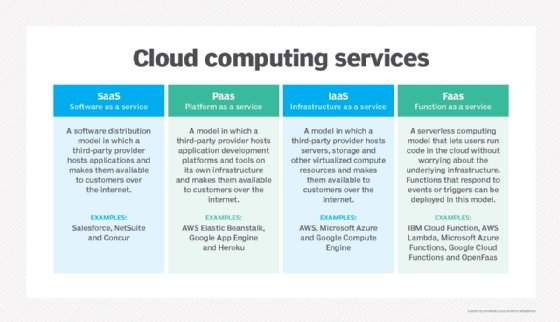Which Cloud Computing Service Model Gives Software Developers
SaaS vs. IaaS vs. PaaS: Differences, Pros, Cons and Examples
There are three major deject service models: software equally a service (SaaS), infrastructure as a service (IaaS) and platform equally a service (PaaS). Cloud service pricing models are categorized into pay per use, subscription-based and hybrid, which is a combination of pay-per-utilize and subscription pricing models.
Software as a Service
Software equally a service vendors host the applications, making them available to users via the cyberspace. With SaaS, businesses don't have to install or download any software to their existing It infrastructures. SaaS ensures that users are ever running the nearly up-to-date versions of the software. The SaaS provider handles maintenance and back up.
Platform as a Service
Platform equally a service offers developers a platform for software development and deployment over the internet, enabling them to access upwardly-to-appointment tools. PaaS delivers a framework that developers tin can use to create customized applications. The organization or the PaaS deject vendor manage the servers, storage and networking, while the developers manage the applications.
Infrastructure equally a Service
Infrastructure as a service is used by companies that don't want to maintain their own on-premises data centers. IaaS provides virtual computing resources over the Internet. The IaaS cloud vendor hosts the infrastructure components that typically exist in an on-premises data center, including servers, storage and networking hardware, equally well equally the hypervisor or virtualization layer.
How Do the 3 Cloud Computing Service Models Differ?
The three cloud service models mainly differ in what they offer out of the box. SaaS is deject-based software that companies tin can buy from cloud providers and use. PaaS helps developers build customized applications via an application programming interface (API) that can be delivered over the deject. IaaS helps companies build the infrastructure of cloud-based services, including software, content or eastward-commerce websites to sell physical products.
Companies that employ SaaS don't accept to manage their data utilize or maintain their applications. With PaaS and IaaS, yet, users must manage their own data use and applications. SaaS and PaaS providers manage organizations' operating systems, simply IaaS users must handle their own operating systems.

SaaS Pros, Cons and Use Cases
Pros of using SaaS include:
- Easy to access and apply: The main benefit of SaaS products is that organizations tin use them equally soon equally they subscribe because it'due south the easiest cloud model to gear up and run. SaaS is also the easiest to maintain considering the deject providers manage everything.
- Scalability: To add together users, organizations just have to upgrade their existing plans or subscriptions. They don't have to buy boosted server space or software licenses.
Cons of using SaaS include:
- Lack of control: Organizations don't take control over their providers' cloud infrastructures. Consequently, if the provider has an outage, they do likewise.
- Event with integrations: Organizations may have trouble integrating their existing in-house software with the SaaS applications, equally their in-business firm APIs and data structures may not integrate with the external applications.
SaaS use cases include enterprise applications for services such as email, sales management, client human relationship management (CRM), fiscal management, human resource management (HRM), billing and collaboration.
PaaS Pros, Cons and Apply Cases
Pros of PaaS include:
- Simplicity, convenience: PaaS providers deliver most of the infrastructure and other It services for organizations, which users tin can admission as long as they have an net connection and a web browser.
- Faster evolution: PaaS platforms provide compute and storage infrastructures, forth with text editing, version direction, compiling and testing services that help developers efficiently build new software. They as well assist development teams work together, regardless of wherever they are physically located.
Cons of PaaS include:
- Lack of scalability: PaaS tools are a little more rigid that IaaS tools, which may exist an event for organizations that experience extremely high demand for their products or services at various times throughout the yr.
- Vendor lock-in: Because PaaS vendors take unique configuration requirements, organizations may find it hard to move from 1 provider to another.
PaaS utilise cases include:
- API evolution: Developers can use PaaS to develop, run, manage and secure APIs and microservices.
- Internet of things (IoT): PaaS supports a variety of application environments, tools and programming languages used for IoT deployments.
- Business analytics: Companies tin apply PaaS tools to clarify their data to uncover business insights for better decision-making.
IaaS Pros, Cons and Employ Cases
Pros of IaaS include:
- Cost efficient: IaaS makes it easier, faster and more cost-constructive for organizations to operate workloads considering they don't have to purchase, manage and support the underlying infrastructure.
- Scalability: The cloud infrastructure ensures that companies take admission to all the resources they demand when they need them.
Cons of IaaS include:
- Security: In an IaaS surround, organizations relinquish control over cloud security to the third-party vendor. So fifty-fifty though a information breach might not directly affect a company's information, the compromised system could still endanger the its operations.
- Technical issues: Some organizations may experience downtime with IaaS that they can't command. Any problems the provider experiences could limit companies' access to the applications and data they need to operate on a daily basis.
Use cases for IaaS include:
- Website hosting: Organizations tin can relieve money using IaaS tools rather than traditional spider web hosting to run their websites.
- Deploying software: Companies can employ IaaS to deploy and run common business software, such as SAP and Salesforce.
- Testing and evolution: IaaS enables developers to more hands calibration upward development and test environments.
SaaS, PaaS and IaaS Providers
SaaS services include:
- Adobe Creative Cloud
- Box
- Salesforce
- Dropbox
- Mailchimp
- Zendesk
- DocuSign
- Slack
- HubSpot
- Google Workspace
- Oracle Fusion Applications
PaaS services include:
- AWS Rubberband Beanstalk
- Oracle Deject Platform
- Google App Engine
- Microsoft Azure
- Red Chapeau OpenShift
IaaS services include:
- Amazon EC2
- Google Compute Engine
- Azure Virtual Machines for Linux and Windows
- Alibaba Elastic Compute Service
- Rackspace Cloud
Additional Cloud Service Models
Other deject service models include:
- Network equally a service ( NaaS ): This cloud calculating model provides organizations access to boosted computing resources co-located with switches and routers. NaaS includes: wide area network (WAN), bandwidth on-demand, flexible and extended virtual private network (VPN), security firewall, custom routing, multicast protocols, antivirus, intrusion detection and prevention, content monitoring, and filtering.
- Monitoring as a service (MaaS): This framework enables companies to deploy monitoring applications online. MaaS tools and applications monitor certain aspects of applications, servers, systems or whatever other Information technology components.
- Database equally a service (DBaaS): Using this deject-based service, organizations tin can store and manage various databases without having to configure and maintain concrete hardware.
- Communications as a service (CaaS): This is an enterprise communications tool that companies can lease from a deject service provider. CaaS includes voice over IP (VoIP), instant messaging, collaboration, and video conference apps using fixed and mobile devices. The CaaS provider manages all the hardware and software.
- Storage every bit a service ( STaaS ): In this cloud model, a big company rents space in its storage infrastructure to a smaller company. STaaS may exist a practiced option for a minor or medium-sized company that doesn't have the capital letter budget or an IT section to implement and maintain its own storage infrastructure.
How to Choose Between SaaS vs. PaaS vs. IaaS
The size of your organization tin can help determine which cloud model to use. A few recommendations include:
Modest/medium/large companies with limited resource: SaaS
Businesses can save coin with software as a service because they don't have to design and develop the software themselves. Information technology makes sense for companies to employ SaaS products that meet their business requirements because they tin quickly be more productive.
Medium/large organizations with some resources: PaaS
Medium and large businesses with IT departments should consider platform equally a service as an option, particularly if they need customized applications that tin can more easily integrate with their workflows and technologies.
Medium/big enterprises with moderate resources: IaaS
Medium and large businesses that have the necessary IT resources should think about using infrastructure every bit a service. The almost complete control that IaaS provides ways they can create highly customized engineering stacks that meet an organization's specific business concern requirements. IaaS also makes it easy to adapt the applied science if business organization requirements change.
Although like, choosing among software as a service, platform as a service and infrastructure as a service ways companies have to observe the correct remainder between giving upward control and saving their employees time and effort then they tin be more productive.
Dig Deeper on Cloud Computing
-

The state of the PaaS business model and market in 2022
-

hybrid IT
-

Empathize deject abstraction for your IT needs
-

deject service provider (cloud provider)
Source: https://whatis.techtarget.com/SaaS-IaaS-PaaS-Comparing-Cloud-Service-Models
Posted by: gibsonficepleturem.blogspot.com






0 Response to "Which Cloud Computing Service Model Gives Software Developers"
Post a Comment